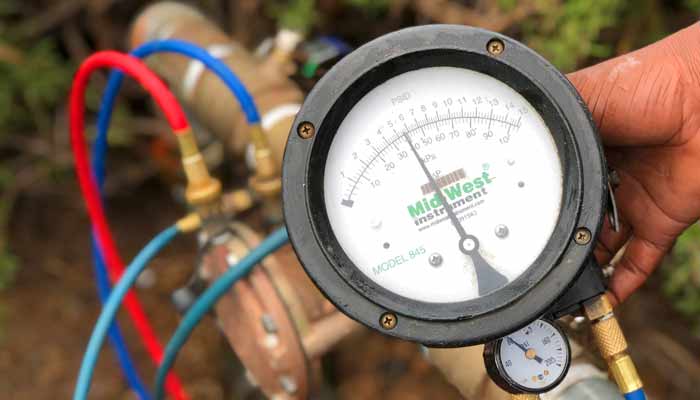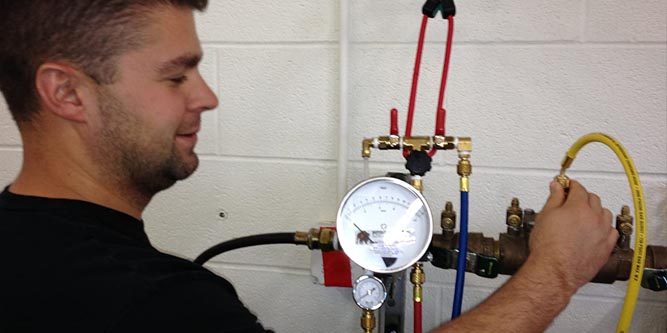Need I Perform Backflow Testing on My Water?
Need I Perform Backflow Testing on My Water?
Blog Article
The author is making a few good points on Commercial Backflow Testing in general in this post beneath.

Yes, you require to backflow examination your residence's water to make certain that the water is without toxic substances as well as dangerous levels of chemicals. You must not try to do backflow testing on your very own since of the devices needed and area for error. We recommend that you call an expert plumber every couple of years to test your water.
What is Backflow?
In other words, heartburn is when water moves upwards-- the opposite instructions in the plumbing system. This is also called "backpressure." When the water moves in this direction, it can combine with dangerous contaminants as well as pose a risk.
What Creates Heartburn?
A typical cause of backflow is a loss of water stress that triggers the water to siphon back right into the water supply. After some time, there is a loss in water stress and also the pipe starts to suck the water back right into the water supply. As you can envision, there are now chemicals from the paint that are entering the water supply, potentially posing a hazard.
Heartburn Testing is Needed by Law in Certain Cities
Depending upon where you live, you may actually be needed by regulation to backflow test your law. As an example, Iowa City keeps a record of all residential properties served by the city's water supply. The city needs that specific "high-hazard" facilities undertake backflow testing. In many cases, residential properties such as residences and also apartment are impacted.
You Can Avoid Backflow
If you have a professional plumber set up a heartburn gadget, dangerous backflow is easily preventable. The plumber will additionally test for backflow and establish if there is an active hazard. The major purpose of a heartburn tool is to avoid water from flowing backward into your water supply. Plumbing technicians set up the tool on the pipes in your home to make sure that the water only flows in the proper direction.
Heartburn Can Impact Both You and also Your City
Lots of cities establish backflow guidelines because dangerous heartburn can affect the public water supply along with a single building. Modern-day cities have backflow tools in area that secure the water supply that comes from a lot of homes as well as industrial properties. The genuine hazard originates from irrigation systems, which can hurt the water supply with hazardous plant foods, manure, and other chemicals.
Call a Plumber to Check for Backflow Prior To It is Far too late
A plumbing business can quickly test your residence's water to identify if there are any unsafe chemical levels. And also if you do uncover that your water has high degrees of toxic substances, a plumber can easily mount a heartburn avoidance device.
Yes, you require to backflow test your house's water supply to make sure that the water is totally free of contaminants as well as hazardous degrees of chemicals. A common reason of heartburn is a loss of water pressure that causes the water to siphon back right into the water supply. After some time, there is a loss in water pressure and the tube begins to draw the water back into the water supply. The major objective of a backflow tool is to prevent water from flowing backwards into your water supply. Numerous cities establish heartburn standards because hazardous heartburn can influence the public water supply in addition to a single structure.
WHY DOES BACKFLOW TESTING NEED TO BE DONE EVERY YEAR
What Is Backflow?
Toxic gas backing up into a building is one example of potential backflow issues, but backflow can occur in many other ways.
Backflow is generally referred to as the reversal of a liquid or gas in a plumbing system.
Most issues for the public occur with backflow resulting in contaminated drinking water. If you look up backflow issues online you’ll probably find references to “potable” water. That means drinking water.
There have been backflow issues in the past with drinking water. Chemicals, sewage and other contaminants have found their way into drinking water causing health issues for those that count on the fresh water.
What Causes Backflow?
In a residence or commercial building water generally flows one way. This normal flow is usually driven by consistent pressure in the water and waste system.
Anything that changes the normal pressure in the system can lead to backflow.
Fire hydrant use or malfunction can reverse the normal pressure in the system on a city line, but backflow can occur in a number of different ways.
Sometimes backpressure might be caused by someone using a garden hose and submerging the end of the hose in a pool of liquid. If pressure is lost the flow could reverse and contaminants could be released into the drinking water.
Anytime there is a connection between contaminants and the drinking water there is potential for a backflow issue. Sometimes these connections are not immediately obvious like the garden hose connecting to a building’s drinking water supply.
Backflow Regulations
The Environmental Protection Agency (EPA) provides guidelines and regulations for state and local governments regarding backflow. State and local governments also have their own guidelines and regulations for backflow prevention.
Arizona has its own backflow regulations.
Due to issues with backflow in the past, regulations require backflow preventer devices to be used in nearly all residential and commercial buildings.
A backflow preventer is a device that prevents backflow as cross-connection points where potential backflow issues may occur.
While backflow is not a common occurrence, preventers are in place to make sure there is no contamination should something malfunction or go wrong with a building’s water supply.

We were guided to that editorial about Commercial Backflow Testing from a good friend on our other web page. Liked our blog? Please share it. Help other people find it. I appreciate reading our article about Is backflow testing necessary?.
Browse Website
Report this page